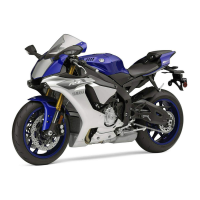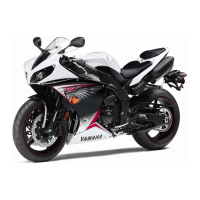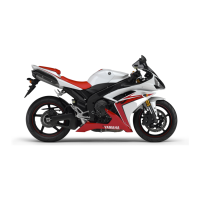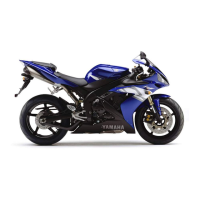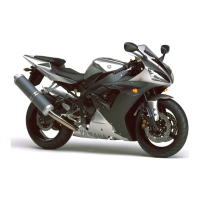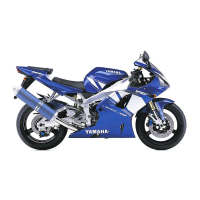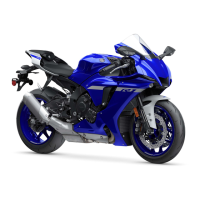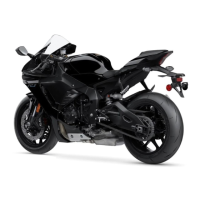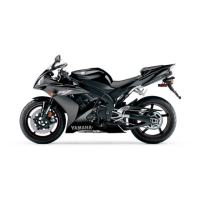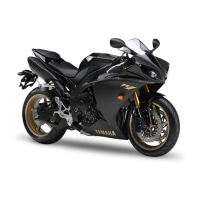Do you have a question about the Yamaha R1 2019 and is the answer not in the manual?
Emphasizes owner's responsibility for safe motorcycle operation and proper usage.
Provides guidelines for safe riding practices and hazard avoidance.
Details essential protective clothing for rider safety and injury prevention.
Warns about the dangers of carbon monoxide and precautions to take.
Advises on proper loading of cargo and accessories to maintain stability.
Illustrates and labels key components visible from the left side of the motorcycle.
Illustrates and labels key components visible from the right side of the motorcycle.
Identifies and explains the various controls and instruments on the handlebars and dashboard.
Introduces the Yamaha Ride Control system and its functions.
Provides definitions for technical terms and acronyms used in the manual.
Offers a visual representation of how YRC functions are applied during riding.
Explains the vehicle's immobilizer system for theft prevention and key registration.
Describes the main switch positions and how to lock the steering.
Details the functions of the left and right handlebar switches.
Identifies and explains the various indicator and warning lights on the instrument panel.
Describes the motorcycle's digital display modes and information shown.
Details the integrated ABS and UBS brake systems and their operation.
Details the system that prevents starting with the transmission in gear or sidestand down.
Details checks for fuel level, line, tank breather, and overflow hose.
Details checks for oil level, adding oil, and oil leakage.
Details checks for coolant level, adding coolant, and cooling system leakage.
Covers tire damage, condition, tread depth, and air pressure checks.
Explains the conditions and steps required to start the engine.
Describes how to shift gears for controlling engine power and smooth operation.
Provides guidelines for the critical engine break-in period for longevity.
Describes the location and purpose of the included tool kit.
Lists scheduled maintenance for emission control system components.
Details routine maintenance and lubrication tasks for various vehicle parts.
Covers tire inspection, air pressure, and replacement guidelines.
Provides information on battery maintenance, charging, and storage.
Explains how to locate and replace fuses in the vehicle's electrical system.
Offers guidance for diagnosing and resolving common vehicle problems.
Advises on special care for matte-finished parts to avoid damage.
Details regular cleaning procedures to maintain appearance and performance.
Provides instructions for storing the vehicle, including long-term storage.
Details the overall dimensions, wheelbase, ground clearance, and weight of the vehicle.
Lists engine type, displacement, bore/stroke, and drivetrain gear ratios.
Covers fuel tank capacity, recommended fuel, and brake system types.
Outlines system voltage, battery specifications, and lighting types.
Explains how to find and record vehicle identification, engine serial, and model label information.
Covers vehicle data recording, diagnostic connectors, and privacy policy.
Emphasizes owner's responsibility for safe motorcycle operation and proper usage.
Provides guidelines for safe riding practices and hazard avoidance.
Details essential protective clothing for rider safety and injury prevention.
Warns about the dangers of carbon monoxide and precautions to take.
Advises on proper loading of cargo and accessories to maintain stability.
Illustrates and labels key components visible from the left side of the motorcycle.
Illustrates and labels key components visible from the right side of the motorcycle.
Identifies and explains the various controls and instruments on the handlebars and dashboard.
Introduces the Yamaha Ride Control system and its functions.
Provides definitions for technical terms and acronyms used in the manual.
Offers a visual representation of how YRC functions are applied during riding.
Explains the vehicle's immobilizer system for theft prevention and key registration.
Describes the main switch positions and how to lock the steering.
Details the functions of the left and right handlebar switches.
Identifies and explains the various indicator and warning lights on the instrument panel.
Describes the motorcycle's digital display modes and information shown.
Details the integrated ABS and UBS brake systems and their operation.
Details the system that prevents starting with the transmission in gear or sidestand down.
Details checks for fuel level, line, tank breather, and overflow hose.
Details checks for oil level, adding oil, and oil leakage.
Details checks for coolant level, adding coolant, and cooling system leakage.
Covers tire damage, condition, tread depth, and air pressure checks.
Explains the conditions and steps required to start the engine.
Describes how to shift gears for controlling engine power and smooth operation.
Provides guidelines for the critical engine break-in period for longevity.
Describes the location and purpose of the included tool kit.
Lists scheduled maintenance for emission control system components.
Details routine maintenance and lubrication tasks for various vehicle parts.
Covers tire inspection, air pressure, and replacement guidelines.
Provides information on battery maintenance, charging, and storage.
Explains how to locate and replace fuses in the vehicle's electrical system.
Offers guidance for diagnosing and resolving common vehicle problems.
Advises on special care for matte-finished parts to avoid damage.
Details regular cleaning procedures to maintain appearance and performance.
Provides instructions for storing the vehicle, including long-term storage.
Details the overall dimensions, wheelbase, ground clearance, and weight of the vehicle.
Lists engine type, displacement, bore/stroke, and drivetrain gear ratios.
Covers fuel tank capacity, recommended fuel, and brake system types.
Outlines system voltage, battery specifications, and lighting types.
Explains how to find and record vehicle identification, engine serial, and model label information.
Covers vehicle data recording, diagnostic connectors, and privacy policy.
| Bore x Stroke | 79.0 mm x 50.9 mm |
|---|---|
| Compression Ratio | 13.0:1 |
| Fuel System | Fuel Injection with YCC-T and YCC-I |
| Ignition | TCI: Transistor Controlled Ignition |
| Transmission | 6-speed; multiplate slipper clutch |
| Final Drive | Chain |
| Front Suspension | 43mm KYB® inverted fork; fully adjustable |
| Rear Suspension | KYB® single shock; fully adjustable |
| Front Brakes | Dual 320mm hydraulic disc; ABS |
| Rear Brakes | 220mm hydraulic disc; ABS |
| Front Tire | 120/70ZR17 |
| Rear Tire | 190/55ZR17 |
| Wheelbase | 55.3 in |
| Seat Height | 33.7 in |
| Fuel Capacity | 4.5 gal |
| Curb Weight | 448 lb |
| Length | 80.9 in |
| Width | 27.2 in |
| Height | 45.3 in |
| Ground Clearance | 5.1 in |
| Maximum Power | 200 HP @ 13, 500 rpm |
| Engine Type | liquid-cooled, 4-stroke, DOHC |
| Maximum Torque | 83 lb-ft @ 11, 500 rpm |


